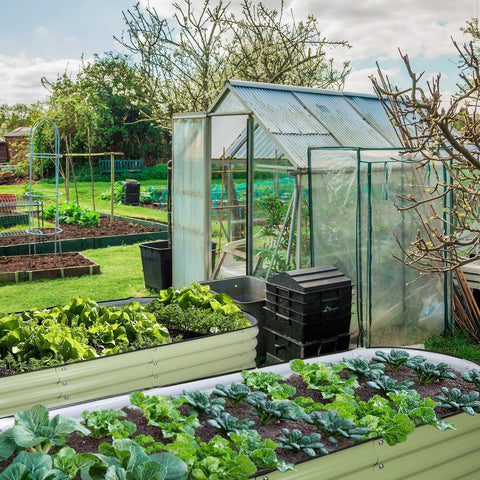Knowledge from Olle Garden Bed: Can You Double Layer Landscape Fabric?
If you have been gardening for some time, you may have dealt with landscape fabrics. Perhaps you have used it to set up mulch to prevent weeds from growing or prepare to plant a garden. If you have encountered this situation, you may want to know whether the double-layer fabric is safe. The following content also has some reference value for raised garden beds.
You can use double-layer landscape fabric. However, it is usually unsafe, especially in your garden. Additional fabric layers may adversely affect the soil. Therefore, double-layer landscape fabric will be counterproductive and may damage your garden.
The rest of this article will explain some topics related to this issue, including the effect of double-layer landscape fabric and how to use gardening equipment. I will also clarify the benefits of using landscape fabrics correctly.

Double suppression of water and air passages
A key component of healthy soil is to allow air and water to pass through, thus nourishing the plants in the garden.
Traditionally, landscape fabrics have been designed with perforations to allow air and water to reach the soil. When installed in a single layer, the fabric ideally allows this passage.
However, when you double layer landscape fabric, the top layer will block the opening at the bottom, so air and water cannot pass through. The extra layer creates a desert environment for your plants, and you think it is nourishing them.
Double layer makes weeding difficult
One of the main concepts of landscape fabrics is that installing them will prevent weeds from sprouting by blocking the sun. However, the system is not 100% effective. Weed seeds can be blown at the top and germinated on the covering used for covering the fabric.
When this happens, weeds can thrive and place their roots on the fabric openings that allow water and air to pass through.
It is easy to deal with the problem in the single-layer landscape structure, because all you need to do is simply pull out the weeds. However, in the double layer, weeds attach to the perforation of the two layers, making weeding a nightmare.
In this case, you may need to remove the entire landscape fabric to effectively weed, which may be very troublesome.
Double-layer blocking nutrition
You can set two layers of landscape fabric. The concept is that it can enhance soil protection and prevent the top cover from rotting, so you don't need to replace it often.
However, this is not the case. Most coverings are made of wood by-products, which will naturally decay when exposed to water, regardless of the environment. In fact, this is the meaning of using products in covering; They decay and form nutrients that seep into the soil.
However, the double layer can prevent nutrients from seeping into the soil due to perforation blockage. Therefore, rotten mulch is wasted instead of making your soil healthier.

How to use landscape fabrics
Now that we have discussed the danger of setting up a double-layer landscape structure, let's see how you should properly install it. You can follow the following simple steps to set up the landscape structure and enjoy its full benefits:
- Measure the garden. Take enough measurements to ensure that you get the right size of landscape fabric for your garden.
- Select professional landscape fabric. The quality of landscape fabrics determines why some are better than others. Landscape fabrics need to effectively prevent the growth of weeds, but allow air and water to pass through.
- Add and grade correction. Before installing the landscape, add soil fertilizer (such as organic matter) to the garden soil, because they cannot be added later. Leveling soil and organic matter to form a flat terrain.
- Arrange the fabric. Place the fabric in the garden and roll it, with the rough part facing down. If you use multiple fabrics, please overlap the edges by several inches or plug one on the other to ensure its fixation.
- Knitted fabrics. Install transverse pins 8 inches (20 cm) apart along the edge of the fabric. Make sure that the pins are firmly connected to avoid loosening.
- Hole cutting. Cut considerable holes around the fabric and make sure they fit the plants you plan to grow.
- Cover it. Cover the fabric with a covering of about 2 inches (5.08 cm) to compress the fabric and enhance soil and plant protection. You can use any covering you like.
Benefits of correctly installing layer landscape structure
After correct installation, your layer landscape structure can provide services for your garden in various ways.
One of the most common benefits is to prevent weeds from growing. The fabric can prevent sunlight from penetrating the soil and prevent weeds from sprouting. If used properly, you don't have to spend a lot of money to buy harmful herbicides (source).
The fabric also helps the soil retain moisture by preventing evaporation. When the soil is exposed, the sun and wind can evaporate all the water and make it dry. This means that your garden will need more water than usual to maintain plant water.
Therefore, the use of fabric can protect it from the influence of such elements. It cultivates healthier soil for plant growth. You will notice that your kitchen and garden will become healthier after installing landscape fabric.

Double-layer landscape fabric in the garden is never a good idea. It promotes unhealthy soil by preventing water, air and nutrients from entering the soil. In addition, when unwanted plants grow from the mulch, weeding is cumbersome and cumbersome.
However, the correct installation of landscape fabric is a simple process, which can produce many benefits. It can protect your garden soil and make it healthier over time. Therefore, do not stop using landscape fabrics, just install them correctly!
